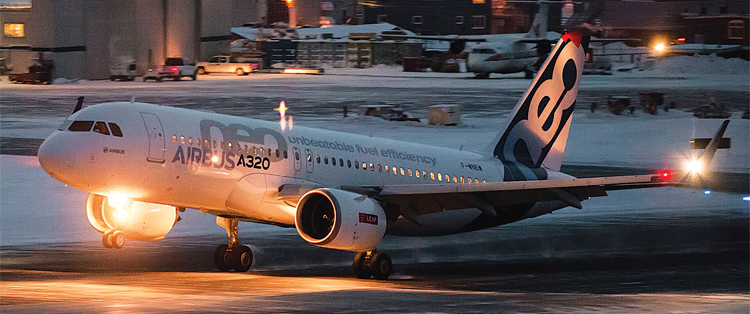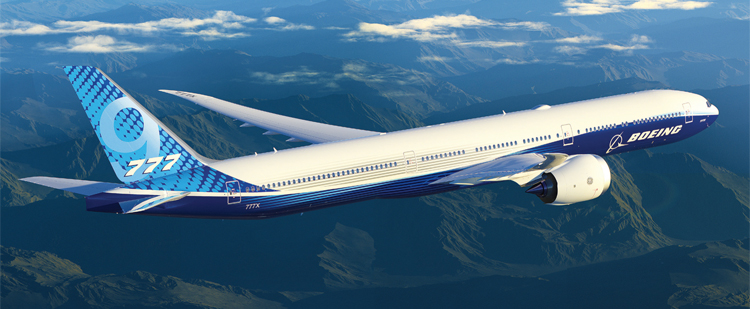Blurring Distinction Between Narrow-Body and Wide-Body Airliners
The major benefit which will emerge is that terribly busy hubs will de-congest with the number of transiting passengers reducing drastically as the layovers at the hubs will be done away with

We are living in very interesting times and are in a position to see and experience major changes happening in the world of aviation. The changes are essentially improvements, which happened incrementally, but if you see a decade or a quarter of a century, the changes are huge. Aviation, both, the civil and military arena has undergone a sea change in the last half a century. The shape, size and capability in terms of altitude, speed and weight of airplanes has reached unbelievable proportions.
These developments have happened primarily because the sheer number of people travelling has exploded. Due to increase in demand, technology has been driven to develop, lighter, stronger and more durable materials, fuel efficient engines, fly-by-wire controls, autonomous navigation systems, and satellite communications systems. The explosion in microprocessor technology has brought in avionics and equipment of unbelievable capability and reliability.
There has been an increase in the number of people travelling because the average person has a larger disposable income and the cost of tickets has been steadily falling; added to this, the entry of the Low Cost Carriers that bank on a “no-frills” and higher load factor travel model - have together created an astronomical demand for airliners. This brings us to the fundamentals of what kind of airliners are needed to service this demand. It will become amply clear that there are three types of stage lengths, short, medium and long routes and three types of traffic densities. To this, one can now add yet another classification, which exists in small numbers only and that is the ULTRA LONG route. To effectively service these diverse requirements, the operators would necessarily need four different types of airliners. Regional Jets are for small capacity and short to medium distance routes, typically in the order of 110 to 120 passengers, over a stage length of up to 200 nautical miles. The medium-sized, single-aisle (narrow-body) airliners with a capacity for 150 to 180 passengers are for medium distance routes up to 1,000 nautical miles. The twinaisle (wide-body) airliners 220-350 passengers for long routes up to 4,000 nautical miles and finally, the twin-aisle airliners capable of flying the ultra long routes of around 8,000 nautical miles, with flying time in the order of 15 to 18 hours.
The choice of airliners to be used on a particular route depends on various factors as under:
- Stage length.
- Passenger traffic density on the route.
- Capability of the aerodrome to handle the airplane.
- Frequency of the flights.
Essentially, one could use any airliner on any route, whatever the stage length, depending upon the passenger load factor. No operator would like to operate the airplane half-empty. So, for all practical purposes, it is the load factor that determines the choice of the type of airplane used. However, there are some technical constraints that come into the picture. The technical life of the airliners, in addition to flying hours, is also governed by cycles. So if one uses an ultra-long haul airplane on short sectors, one may run out of airplane life based on cycles.

The long routes, in excess of five to six hours were beyond the capability of the single aisle airplanes in terms of range, so the Regional Jets and single-aisle airliners were, in a manner of speaking, ruled out of the niche area of long routes, which are typically akin to international routes. They became the sole domain of the twin-aisle airplanes. In effect, short routes became the domain of regional jets, medium-stage length routes for the single-aisle, narrow-body, medium-haul airliners and the intercontinental routes got reserved for the twin-aisle, wide-body airplanes. The ‘ultra long haul routes’ which were and still are few and far between, were the sole domain of the few ultra long haul airplanes.
This actually created a completely unique operational philosophy. Passengers wanting to fly to intercontinental destinations had to perforce fly in to airports from which they could take a flight to the desired international airport. On arrival at point of entry, if that was not the final destination, they had to take another flight to the destination. So one had to fly along a spoke to a hub and upon arrival, then fly from a hub along a spoke to the destination. That is how the ‘Hub-and-Spoke’ operations began. It was undoubtedly efficient and optimised use of resources, but it also had its share of problems.
ENTER THE NEO
Airbus launched the ‘neo’ on the A320 family on December 1, 2010. Though neo stands for “New Engine Option” - the A320neo family comprised quite a few airframe modifications in addition to the new engines. The engine options were the CFM Leading Edge Aircraft Propulsion (LEAP) and the Pratt & Whitney 1000/1100 engine series. The benefits of the two, aerodynamic modifications and the new engine put together, gave an overall efficiency of an unbelievable, 20 per cent. This enabled the A320 to achieve a range of 3,600 nautical miles with 180 passengers and the A321, an unbelievable range of 4,000 nautical miles with 220 passengers in a two-class configuration. In this configuration, it was in somewhat the same league as the smaller wide-body airplanes. Its own older brother, the A330-200 could carry 220 passengers in two-class configuration. Only the A330-200 ran at 230 tonne compared to the sub-100 tonne of the A321. Undoubtedly, the A330 could fly over a much longer distance, but 4,000 nautical miles enabled the A321neo to go trans-Atlantic with the same passenger load as the A330. This was the game changer.
Armed with a very positive feedback from the market, Airbus went boldly ahead with the development of the A321neo XLR. To give a very simple comparison of the range capability of three neo siblings is as follows A321neo +15 per cent equals A321 LR +15 per cent equals A321neo XLR. The A321neo XLR would weigh 101 tonne, carry 220 passengers in two-class configuration with full flat beds in Business Class, over a range of 4,700 nautical miles. To spell out its capability in flesh and blood terms, Chennai to London Heathrow is 4,450 nautical miles. Hence from any airport in India to London and therefore, any airport in Europe becomes a normal operating non-stop flight. London to New York across the Atlantic is barely 3,000 nautical miles. Flights across the Atlantic can be operated with 220 passengers in a two-class configuration by a single-aisle airplane with sub-100 tonne AUW. Put simply, it will be carrying the passenger load of an entry level wide-body airliner.
To draw meaningful comparisons, an A330-200 in erstwhile Jet Airways configuration, carried 220/256 passengers in two classes. The A321neo XLR would be doing about the same. However, the A330 weighed 230 tonne and the A321neo XLR would weigh 101 tonne. The complement of cockpit crew and cabin crew would remain the same, so would the other ancillary expenses. The savings are going to be on the operating costs. One does not need a calculator or higher mathematics to determine that the fuel and operating costs of a 230-tonne machine versus a 101-tonne machine are going to be significantly higher.

On the face of it, a difference in passenger carrying capability, and the range of the airplane on a large number of sectors, of up to ten hours stage length, is non-existent. The clearly defined lines that separated the wide-bodies from the narrow-bodies are slowly getting erased. Longer sectors beyond 12 hours duration are referred to as ‘Ultra Long Haul’ and these will remain the exclusive domain of the wide-bodies, at least in the foreseeable future.
Despite the fact that seats in Economy and Business class would be roughly the same, equipped with individual seat ‘In Flight Entertainment’, the comfort level of the wide-body versus a narrow-body can never be duplicated. The free-aisle space to walk around, the greater number of toilets and some free areas to lounge around will simply not be available. Especially since moving around on one’s feet is a recommended activity on long flights. On an A330, the standard seating in Economy class is eight abreast in a 2-4-2 configuration. A passenger is never more than one seat away from the aisle. On a narrow-body, the typical seating is 3-3. The window seat occupant is two seats away from the aisle. This discomfort is something the passengers will have to bear.
COVID-19 PANDEMIC
In March this year, the world was hit with the COVID-19 pandemic. The very first precaution all governments took was to stop air travel. All aviation activity was brought to a complete halt. Even now, in India the domestic flights are permitted up to 70 per cent of pre-Covid level. International travel remains severely restricted. All industries across the board have taken a hit, but the biggest sufferers are the airlines. As an immediate fallout, the ‘Jumbo’ (Boeing 747) and the ‘Super Jumbo’ (A380) have been pushed into premature retirement by virtually all operators. The largest airplanes in the skies today are the Boeing 777 and A350 XWB, which are being dubbed as the “mini-jumbos”. Slightly smaller are the Boeing 787 and A330. Almost there to compete, is the Airbus A321neo XLR and in the foreseeable future, the Boeing 737 MAX-10. These two single aisle airplanes are muscling their way in and competing with the widebody airplanes in terms of seating capability.
Undoubtedly, the competing wide-body airplanes are capable of ranges in excess of 7,500 nautical miles; the narrow-body types listed above are giving them a run for their money on sectors of up to 4,700 nautical miles. They are capable of carrying a similar number of passengers and can comfortably go Trans-Atlantic, the busiest route in the world. The associated fringe benefits of using narrow-body airplanes across the Atlantic are that they do not have to go from ‘Hub-to-Hub’. They can operate from a large number of secondary airports in Europe to an even larger number of secondary airports in the USA. They can also do Hawaii to continental USA, as also Tokyo to Hawaii and at a pinch, with a slightly reduced payload from Sydney to Hawaii.
The major traffic benefit which will emerge is that terribly busy hubs will de-congest. The number of transiting passengers will reduce drastically. Journey times will reduce as the layovers at the hubs will be done away with. The niche area of some of the wide-body airplanes is slowly but surely being invaded by these two narrow-body types. The ultra long haul sectors will remain the exclusive domain of the wide-body airplanes, but in the eight to ten-hour sectors, the narrow-body airplanes are here to stay.
The loss of revenue due to the inability of carrying cargo in passenger flights will be offset by dedicated cargo airplanes. The Boeing 747s and the A380s, retired from passenger carrying, are slowly but steadily heading in the direction of being converted into dedicated cargo airplanes. As far as airlines are concerned, passenger traffic is unlikely to return to pre-Covid level for the next few years. It is, without a doubt, far cheaper to haul 220-230 passengers in a 100-tonne airplane than a 230-tonne airplane. No doubt, passengers will feel the pinch of lack of space and the comfort of the wide-body, but economics just may overtake passenger comfort. Therefore, the distinction between the wide-body and narrow-body airplanes is definitely and positively blurring.





